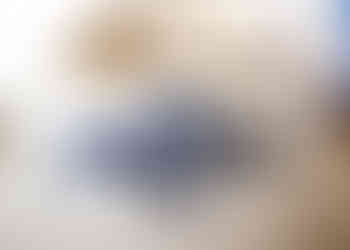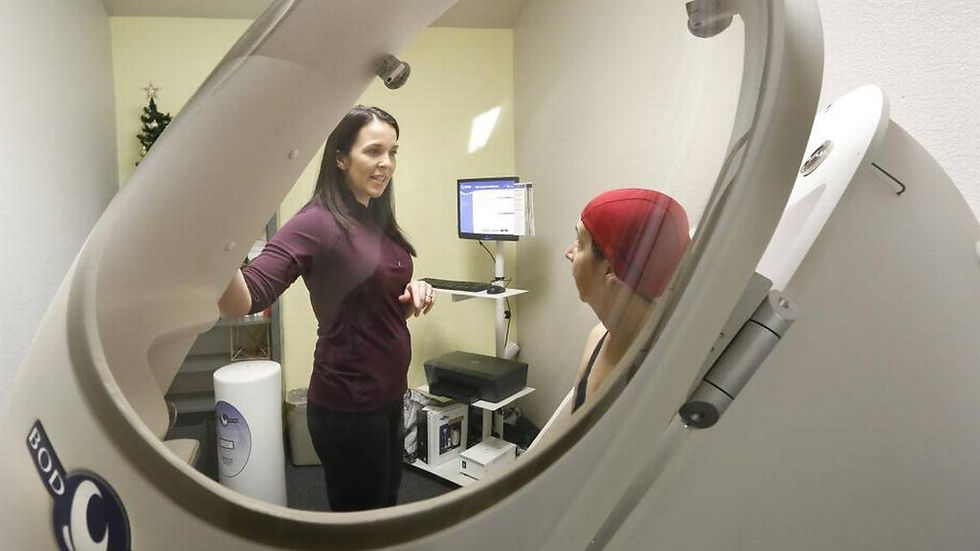BOD POD vs. DEXA: Which is best for body fat analysis?
- Kelly Sherman, MS, NC, CPT

- Jul 13, 2021
- 4 min read
Updated: Jun 10, 2024
Many times, clients ask me what the difference is between the two methods of body fat analysis. Here's everything you need to know!
Technology BOD POD The BOD POD is an air displacement plethysmograph (an instrument that measures changes in volume) that uses whole-body densitometry to calculate body composition. Similar to underwater weighing, it relies on a mass measurement from a scale (which is accurate within a gram!) as well as a volume measurement from the BOD POD chamber. Using these two variables, body density can be calculated. With the density, relative proportions of body fat and lean body mass can be determined.
Hydrostatic weighing, the underwater weighing method, is considered the Gold Standard of body composition analysis along with BOD POD measurement. The BOD POD’s Air Displacement Plethysmography has eliminated the invasiveness of Dual Energy X-Ray Absorptiometry (DXA) as well as the difficulties associated with underwater submersion in hydrostatic weighing.
The BOD POD is calibrated each morning and between every test performed to ensure accuracy in the reading. As long as you do your part to prep for the test, the BOD POD will do it's job to give you an accurate measurement!
DEXA DEXA stands for dual energy x-ray absorptiometry and uses low-energy X-ray beams that aim for your body. The exam table then measures how many rays are absorbed by the body. Since bodily tissues have different densities and thus absorb a different number of rays, a measurement of body composition can thus be computed.
Results
BOD POD
BOD POD results consist of data pertaining to total body weight, density, fat and fat-free mass.
DEXA DEXA scan results give a detailed snapshot of your body composition, including measurements on body fat percentage. Unlike the BOD POD, the DEXA scan can also show segmental body fat distribution in regions such as arms, legs, android (waist), and gynoid (hips) so that you can identify imbalances in the body. Moreover, it can distinguish between visceral and subcutaneous fat in the android region and further provide implications on health risks for certain diseases.
To better understand your body fat percentage level, it is usually recommended to refer to a body fat percentage chart or classification. It is important to note that different tests (BOD POD vs. DEXA) will have different charts, so it is usually not possible to compare results from these two tests.
Although DEXA can show segmental body fat distribution, it is also important to remember that where fat loss is concerned, it is not possible to spot reduce. For health purposes, however, this information can provide valuable insight into the type of fat you may be storing.
Procedure BOD POD The BOD POD procedure is very simple and takes 5-8 minutes with less than two minutes in the actual chamber. First, you will be weighed using a very precise scale that is integrated into the BOD POD machine. Afterward, you will be instructed to sit inside the egg-shaped BOD POD chamber for around 2 minutes, breathing normally. The body volume will be measured in two brief 45 second measurement periods.
Because the BOD POD relies on volume measurements, it is important that you do not exercise or eat/drink two hours prior to the test. This is crucial since any food intake or physical activity can alter your mass and volume. Additionally, it is recommended that individuals also wear form-fitting, spandex-type compression clothing to minimize volume. A swim cap will be provided during testing. Clothing, hair, and any accessories will have an impact on volume and mass measurements.
DEXA The DEXA scan takes approximately 15 minutes. You will be asked to lie down on an exam table while an imaging arm hovers over your body.
Unlike the BOD POD, you can eat or drink normally on the day of the procedure. However, you will be asked to change into a hospital gown and remove any metal objects in order to minimize interference with the X-ray.
Accuracy Both the BOD POD and the DEXA provide body composition measurements with clinical grade accuracy. A DEXA scan has a very low error rate of 1-2%, compared to 5-15% for most methods. This is due to the advanced X-ray technology that leave little guesswork and no extra calculations to provide accurate data. The BOD POD which uses air displacement technology is considered to be the gold standard of body composition measurement. It is as accurate as hydrostatic (underwater) weighing, but quicker and easier to perform. The range of error for this test is ± 1 to 2.7%
Safety BOD POD The BODPOD is completely non-invasive and is especially suitable for frequent tracking of body composition over long periods of time. The BOD POD is ideal for assessing the body composition of special populations such as children (young children from 2 to 6 years with Pediatric Option), the elderly, the disabled and subjects weighing more than 250 kg (500lb) or with heights above 2 meters (6.5ft).
DEXA The DEXA scan does involve some exposure to radiation. However, the level of radiation you are exposed to during the scan is minimal and is similar to the amount you would encounter while on a transcontinental airplane flight. Furthermore, according to the Radiological Society of North America, “modern x-ray systems have very controlled X-ray beams and dose control methods to minimize stray (scatter) radiation. This ensures that those parts of a patient's body not being imaged receive minimal radiation exposure.” Pregnant women should still caution using the test. Interested in having your body composition tested? Click below to book your package now with Provision Nutrition!

Kelly Sherman, MS, NC, CPT, is a licensed nutritionist specializing in empowering women to reclaim their health by cutting through misinformation and ditching the diet culture. She has a master’s degree in nutrition and is degreed in exercise science as well as a certified personal trainer. With over 20 years of experience in the field, she combines the best of both nutrition and exercise sciences to best help her clients reach their potential. To nourish is to flourish!








Comments